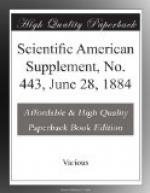“Many questions and problems, in physics as well as in chemistry, find their solution only with the aid of mathematics and mechanics. It therefore became necessary, through lectures bearing upon the useful branches of mathematics, to supplement the too limited ideas that pupils brought with them on entering the school. Mathematics and mechanics are therefore taught here at the same time with physics and chemistry, but they are merely regarded in the light of auxiliaries to the latter.
“The studies extend over three
years. Each of the three divisions
(1st, 2d, and 3d years) includes
thirty pupils.
“During the three first semesters,
pupils of the same grade
attend lectures and go through manipulations
in chemistry,
physics, mathematics, and draughting
in common.
“At the end of the third semester
they are divided into 10
physical and 20 chemical students.
“From this moment, although certain courses still remain wholly or partially common to the two categories of pupils (physical and chemical), the same is no longer the case with regard to the practical exercises, for the physical students thereafter manipulate only in the physical laboratories, and the chemical only in the chemical laboratories; moreover, the manipulations acquire a greater importance through the time that is devoted to them.
“At each promotion the three first semesters are taken up with general and scientific studies. Technical applications are the subject of the lectures and exercises of the three last semesters. At the end of the third year certificates are given to those pupils who have undergone examination in a satisfactory manner, and diplomas to such as have particularly distinguished themselves.”
When pupils have been received at the school, after passing the necessary examination, their time of working is divided up between lectures and questionings and different laboratory manipulations.
The course of lectures on general and applied physics comprises hydrostatics and heat (Prof. Dommer), electricity and magnetism (Prof. Hospitalier), and optics and acoustics (Prof. Baille). Lectures on general chemistry are delivered by Profs. Schultzenberger and Henninger, on analytical chemistry by Prof. Silva, on chemistry applied to the industries by Prof. Henninger (for inorganic) and Prof. Schultzenberger (for organic). The lectures on pure and applied mathematics and mechanics are delivered by Profs. Levy and Roze.




